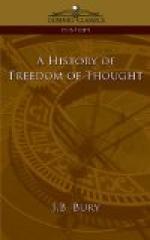The firm belief in witchcraft, magic, and demons was inherited by the Middle Ages from antiquity, but it became far more lurid and made the world terrible. Men believed that they were surrounded by fiends watching for every opportunity to harm them, that pestilences, storms, eclipses, and famines were the work of the Devil; but they believed as firmly that ecclesiastical rites were capable of coping with these enemies. Some of the
[67] early Christian Emperors legislated against magic, but till the fourteenth century there was no systematic attempt to root out witchcraft. The fearful epidemic, known as the Black Death, which devastated Europe in that century, seems to have aggravated the haunting terror of the invisible world of demons. Trials for witchcraft multiplied, and for three hundred years the discovery of witchcraft and the destruction of those who were accused of practising it, chiefly women, was a standing feature of European civilization. Both the theory and the persecution were supported by Holy Scripture. “Thou shalt not suffer a witch to live” was the clear injunction of the highest authority. Pope Innocent VIII issued a Bull on the matter (1484) in which he asserted that plagues and storms are the work of witches, and the ablest minds believed in the reality of their devilish powers.
No story is more painful than the persecution of witches, and nowhere was it more atrocious than in England and Scotland. I mention it because it was the direct result of theological doctrines, and because, as we shall see, it was rationalism which brought the long chapter of horrors to an end.
In the period, then, in which the Church exercised its greatest influence, reason was
[68] enchained in the prison which Christianity had built around the human mind. It was not indeed inactive, but its activity took the form of heresy; or, to pursue the metaphor, those who broke chains were unable for the most part to scale the walls of the prison; their freedom extended only so far as to arrive at beliefs, which, like orthodoxy itself, were based on Christian mythology. There were some exceptions to the rule. At the end of the twelfth century a stimulus from another world began to make itself felt. The philosophy of Aristotle became known to learned men in Western Christendom; their teachers were Jews and Mohammedans. Among the Mohammedans there was a certain amount of free thought, provoked by their knowledge of ancient Greek




